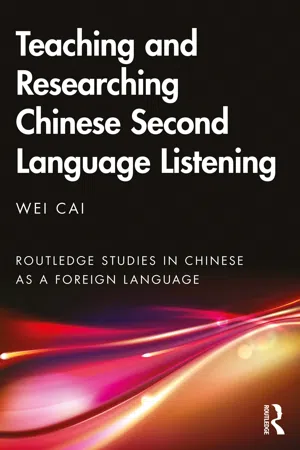The top-down view of language comprehension
As another influential language comprehension view, the top-down model depicts listening as a process in which listeners engage in hypothesis testing with their background knowledge and then selectively process textual information to test the hypothesis. This model emphasizes that context and general world knowledge can impact the processing of smaller units, such as word recognition and syntactic parsing.
A typical example of top-down models is the schema theory, which has deeply influenced L2 listening. While reading is depicted as a psycholinguistic guessing game (Goodman, 1967), listening proves to be more so in the sense that “listeners rely more on top-down, schema-based processing than readers” (Lund, 1989, as cited in Field, 2004, p. 93). Bartlett (1932) introduces the term schema to refer to “an active organization of past reactions, or past experiences” (p. 201). This definition is broad in scope. Rumelhart (1980) adds clarity by refining the definition: “a schema … is a data structure for representing the generic concepts stored in memory. There are schemata representing our knowledge about all concepts” (p. 34).
The above two definitions together highlight three important features of schemata: they are broad, organized, and active. Schemata are broad as we have schemata for all the regularly occurring events (Buck, 2001). Schemata are organized: the huge amount of knowledge stored in our minds and the efficiency with which we retrieve related knowledge together indicate that the storage of knowledge is a well-organized structure. As Rost (2002) points out, “the conceptual knowledge that the listener brings to text comprehension is organized in ways that allow him to activate it efficiently” (p. 62). Finally, schemata are active in the sense that they play an active role in language comprehension. According to schema theory:
a schema…serves as a control structure that regulates comprehension process in a top-down fashion. It works, on the one hand, like a perceptual filter, in that it admits material consistent with itself but blocks irrelevant material, and, on the other hand, it serves as an inference machine, in that it fills in the gaps that are inevitably found in the actual stimulus material.
(Kintsch, 1998, p. 94)
These features of schemata are important for explaining why prior knowledge influences language comprehension easily and extensively.
Schema theory improves on bottom-up models in understanding comprehension as a process in which the text and the comprehender’s prior knowledge interact. Nassaji (2002), in his critical analysis of schema theory in relation to reading comprehension, encapsulates three important insights of the theory: “the constructive nature of the reading process”; “the critical role of the reader”; and “the interaction between the text and the reader’s background knowledge” (p. 80). These ideas are currently widely accepted by researchers in the psychology of reading and are believed to apply to listening (e.g., Anderson & Lynch, 1988; O’Malley et al., 1989; Long, 1990; Rost, 1990; Buck, 1992). For instance, Anderson and Lynch (1988) argue that “the listener has a critical role to play in the process, by activating various types of knowledge, and by applying what he knows to what he hears and trying to understand what the speaker means” (p. 6). The importance of schemata in listening comprehension has been largely recognized. For instance, O’Malley et al. (1989) argue that schemata can help listeners to anticipate information and predict outcomes and infer meanings when one’s comprehension is incomplete. Similarly, Long (1990) states that schemata can fill in information and provide a context to facilitate comprehension.
In spite of the important ideas of schema theory, it has been critiqued for at least three reasons. First, schema theory views language processing as a method of testing hypotheses, in which one first generates hypotheses and then attempts to verify them by processing linguistic stimuli selectively. Stanovich (1980) questions this top-down view because generating and verifying hypotheses “requires implausible assumptions about the relative speeds of the process involved” (p. 34). Generating hypotheses is unlikely to take place more quickly than straightforward decoding of stimuli. Likewise, Field (2008b) points out that drawing upon information from context or co-text (the linguistic context or the internal context of a discourse) is a much slower process than using input or straightforward decoding in fluent L1 listening. Furthermore, Field argues that there is no fixed relationship between the use of input and context, and a balance needs to be stricken between “confidence in the input and the need to draw upon external information” (p. 135). This applies to both L1 and L2 listening.
A second critique of schema theory relates to its rigid nature. Schema theory understands schemata as pre-existing knowledge structures. Kintsch (1998) points out that “human comprehension is incredibly flexible and context-sensitive. It is hard to see how one could model that process with fixed control structures like schemas” (p. 94).
Finally, schema theory underplays lower-level linguistic processing, such as word decoding and syntactic parsing. Although schema theory claims that efficient comprehension depends on both linguistic processing and background knowledge activation, the two processes do not actually receive equal attention, with more emphasis being placed on the latter. However, empirical studies support the view that lower-level linguistic processing is actually basic to successful listening comprehension (e.g., Tsui & Fullilove, 1998; Wu, 1998).
A few more words are needed on the application of bottom-up and top-down models to L2 listening studies. The most crucial difference between the two models is in the processing direction (Field, 2004). However, the terms bottom-up and top-down are loosely defined and used in L2 listening. Bottom-up largely refers to basic linguistic skills, such as the skills involved in sound discrimination, word decoding, and syntactic parsing. Top-down, on the other hand, often refers to the use of context and world knowledge to make sense of a text (e.g., Vandergrift, 2007). It could also refer to the use of cognitive strategies (such as...
